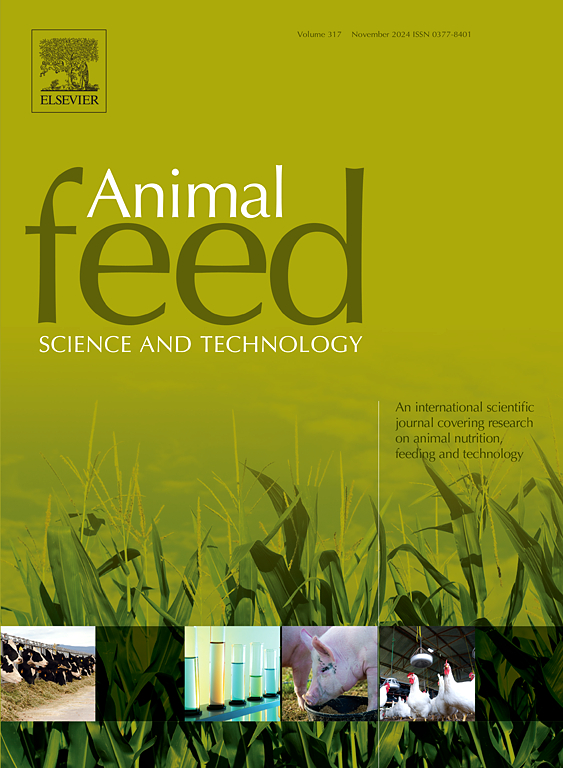Interactions between different single protein and feeding level on growth performance, hepatic lipid metabolism and health of largemouth bass (Micropterus salmoides)
IF 2.7
2区 农林科学
Q1 AGRICULTURE, DAIRY & ANIMAL SCIENCE
引用次数: 0
Abstract
In order to evaluate the effects of the interaction between different single novel proteins and feeding levels on largemouth bass (Micropterus salmoides), and to provide scientific guidance for the application of novel proteins and the corresponding optimal feeding strategy, five single protein diets (fishmeal (FM), Clostridium autoethanogenum protein (CAP), Tenebrio molitor (TM) Chlorella meal (ChM), cottonseed protein concentrate (CPC)) and three feeding levels (100 %,80 % and 60 % satiety feeding) were designed to feed largemouth bass (weight: 2.96 ± 0.08 g) for 8 weeks. Z-score combined with cluster analysis were used to analyze and compare the effects of different treatments on different indexes, such as growth performance, feed utilization, liver antioxidant capacity and immune response as well as lipid metabolism to draw a general picture of the relationship among all these massive biomarkers. The results showed that different novel protein sources and feeding levels had significant interactive effects on growth performance, feed utilization efficiency, body lipid and liver health of largemouth bass. Fish fed with ChM diet showed similar performance to that in FM group, implying its potential for complete replacement of fishmeal in largemouth bass. Fish fed with CAP, TM and CPC diets showed the worst performance by poor growth and feed utilization, enhanced stress, chronic inflammation, varies symptoms of histological changes in the liver and intestine, which demonstrated the adverse effects of the complete replacement of fishmeal by these three new proteins. As for feeding level, 100 % feeding level resulted in hypertrophy and fat accumulation in the liver of fish fed with FM and ChM diets and had risks of fatty liver. In addition, the TM and CPC group had the higher expression levels of inflammatory factors and the lower antioxidant enzymes activity at 100 % feeding level, and CAP group showed the higher expression levels of inflammatory factors at 60 % feeding level, which displayed that the interactions between CAP, TM, CPC diets and 100 % feeding level or 60 % feeding level may aggravate the occurrence of liver inflammation and oxidative damage of hepatocytes. Overall, 80 % feeding level had higher feed efficiency, protein efficiency, antioxidant enzyme and lysozyme activities, lower MDA content and lower gene expression of inflammatory cytokines and could be considered as the optimum feeding level for largemouth bass fed with different protein diets.
不同单蛋白和摄食水平对大口黑鲈生长性能、肝脏脂质代谢及健康的相互作用
为了评估不同单一新型蛋白质和饲喂水平之间的相互作用对大口鲈鱼(Micropterus salmoides)的影响,并为新型蛋白质的应用和相应的最佳饲喂策略提供科学指导、设计了五种单一蛋白日粮(鱼粉(FM)、自乙醇梭菌蛋白(CAP)、小球藻粉(ChM)、棉籽蛋白浓缩物(CPC))和三种饲喂水平(100 %、80 % 和 60 % 饱食饲喂)来饲喂大口鲈(体重:1:2.96 ± 0.08 克),为期 8 周。采用 Z 评分结合聚类分析的方法,分析和比较不同处理对不同指标的影响,如生长性能、饲料利用率、肝脏抗氧化能力和免疫反应以及脂质代谢,从而得出所有这些大量生物标志物之间关系的总体图谱。结果表明,不同的新型蛋白质来源和饲喂水平对大口鲈鱼的生长性能、饲料利用效率、体脂和肝脏健康有显著的交互影响。用 ChM 日粮喂养的鱼表现出与 FM 组相似的生长性能,这表明 ChM 有潜力完全替代鱼粉喂养大口鲈鱼。用 CAP、TM 和 CPC 日粮喂养的鱼表现最差,生长和饲料利用率低,应激增强,慢性炎症,肝脏和肠道出现不同的组织学变化症状。在饲喂量方面,100% 的饲喂量会导致 FM 和 ChM 日粮喂养的鱼类肝脏肥大和脂肪积累,有脂肪肝的风险。此外,在 100 % 的饲喂水平下,TM 和 CPC 组的炎症因子表达水平较高,抗氧化酶活性较低,而在 60 % 的饲喂水平下,CAP 组的炎症因子表达水平较高,这表明 CAP、TM、CPC 日粮与 100 % 或 60 % 的饲喂水平之间的相互作用可能会加重肝脏炎症的发生和肝细胞的氧化损伤。总之,80%的饲喂水平具有更高的饲料效率、蛋白质效率、抗氧化酶和溶菌酶活性、更低的MDA含量和更低的炎症细胞因子基因表达,可被视为不同蛋白质日粮饲喂大口鲈的最佳饲喂水平。
本文章由计算机程序翻译,如有差异,请以英文原文为准。
求助全文
约1分钟内获得全文
求助全文
来源期刊

Animal Feed Science and Technology
农林科学-奶制品与动物科学
CiteScore
6.00
自引率
6.20%
发文量
266
审稿时长
3 months
期刊介绍:
Animal Feed Science and Technology is a unique journal publishing scientific papers of international interest focusing on animal feeds and their feeding.
Papers describing research on feed for ruminants and non-ruminants, including poultry, horses, companion animals and aquatic animals, are welcome.
The journal covers the following areas:
Nutritive value of feeds (e.g., assessment, improvement)
Methods of conserving and processing feeds that affect their nutritional value
Agronomic and climatic factors influencing the nutritive value of feeds
Utilization of feeds and the improvement of such
Metabolic, production, reproduction and health responses, as well as potential environmental impacts, of diet inputs and feed technologies (e.g., feeds, feed additives, feed components, mycotoxins)
Mathematical models relating directly to animal-feed interactions
Analytical and experimental methods for feed evaluation
Environmental impacts of feed technologies in animal production.
 求助内容:
求助内容: 应助结果提醒方式:
应助结果提醒方式:


